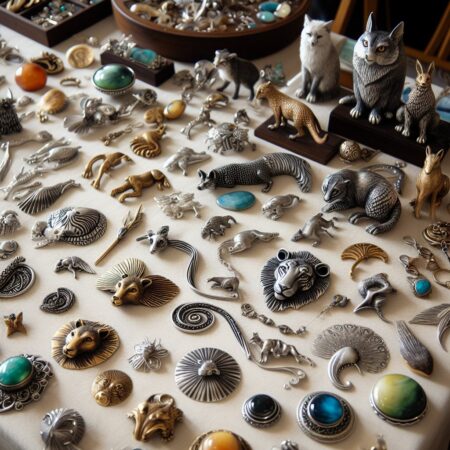Symbols of feminine power have existed since antiquity.
Symbols of feminine power represent feminine characteristics, such as their caring and loving nature, the strength of character, and mental sophistication. Flowers, animals, and goddesses are among the numerous and prominent feminine symbols. These same symbols have been used to depict the feminine’s strength, vigor, and energy. Some of these feminine symbols, such as the moon, are inspired by nature, while others are more esoteric, artificial artifacts that continue to spark discussion and debate.
Certain natural elements, such as the moon, symbolize feminine strength. Elephants and orcas have matriarchal inclinations and emanate a strong feminine spirit. Throughout history, flowers such as the Rose and Lily have represented feminine characteristics.
Xinar proudly presents many such symbols as silver charms for various DIY jewelry.
The Psychology Behind Symbols of Feminine Power
Femininity refers to the features and actions a society deems desirable for women and girls or suited for them. In contrast to femaleness, a biological and physiological categorization related to reproduction, femininity relates mainly to socially learned features and secondary sex characteristics. In Western society, femininity has historically been associated with characteristics such as gentleness and patience.
To classify human qualities and actions as “feminine” or “masculine” is to rely on the prevailing culture of any given country and essentialist concepts of the binary woman/man. Traits that are traditionally considered feminine can be categorized as biologically-based physical differences.
Some strains of feminism acknowledge the presence of a universal feminine that manifests in culture and mythology. The 1992 book “Women Who Run With Wolves” is a classic reading of the feminine through Jungian psychology.
Estés, a psychologist, poet, and cantadora (literally, “keeper of ancient stories”), uses Jungian archetypes, hag tradition, and animal observation to construct alternative feminine mythology. She evokes imagery of a goddess delivering a child in a squatting position, “the sharp odor of iron from the fresh blood of childbirth,” “the force of the haunches,” and “the spiritual placenta.” She explains why in her introduction: “Over time, the innate feminine nature has been plundered, pushed back, and overbuilt,” she says. However, “women’s waning energy can be revived by thorough ‘psychoarcheological’ excavations into the feminine underworld.” There, we may discover the “deepest character of women” and have access to “the creative feminine.”
A decade later, “Women Who Run With the Wolves” has returned to a world suddenly saturated with primitive images of women’s bodies – spilling with blood, running with hormones, and pulsating with anguish and excitement. Menstruation, childbirth, menopause, and gender change are frequently depicted in theater, television, memoir, and art. Instagram is overrun with photos of women frolicking nude through the woods and giving birth in living rooms, with the hashtags like #witch, #wildwoman, and #laloba, the Spanish feminine form of a wolf. Related consumer goods are abundant.
Powerful Symbols of Femininity
As one of the most well-known of the symbols of feminine power, the moon is considered feminine in whatever form. Consequently, it has been connected with some goddesses from different mythologies, including the Egyptian goddess Isis, the Japanese goddess Tsukuyomi, and the Greek goddesses Selene, Artemis, Demeter, Persephone, and Hecate.
Several factors contribute to these relationships. The lunar month was frequently associated with the female menstrual cycle. Moreover, it is thought that the moon mimics the natural contours of a woman’s body. In many civilizations, humans believed in the strength and feminine spirit of the moon, and they tapped into it by invoking lunar deities, the moon-related goddesses.
Cats have coexisted with humans for millennia and have a sophisticated and graceful demeanor. In addition, they possess mysterious femininity that has always been cherished and revered, making them part of our list of symbols of feminine power.
Cats provide delight and subtle pleasure that other animals typically do not. The physical look of cats is less macho than that of dogs. They prefer to bond with the moon than the sun. Cats possess a feminine allure as opposed to an openly male might.
Cats’ enigmatic feminine characteristics are a creative and positive representation of femininity. Cats may also represent pregnant ladies, and their femininity is associated with the moon. Additionally, cats often represent the negative characteristics of femininity, such as cunning and destructiveness.
Venus Symbol
This symbol commonly represents females and consists of a circle with a cross affixed to the bottom, that makes the Venus symbol perfect for our collection of symbols of feminine power. The picture, known as the Venus sign, represents the Roman goddess Venus (Greek counterpart Aphrodite). The design is based on the old Greek letters for Venus, the classical planet. A version consists of two interlaced Venus symbols, which are seen as a lesbian emblem.
Venus and Mars, according to legend, were Cupid’s parents. It is a frequent portrayal of women nowadays. It resembles a circle with a cross beneath it. The Symbol itself depicts Venus, the hand mirror of the Goddess.
As Venus was the goddess of beauty and love, the statue is a powerful symbol of femininity. In addition, the chemical symbol for copper is also represented as the symbol for Venus. This is because copper was utilized to create hand mirrors in antiquity.
Triple Moon Sign
The Triple Moon is one of the most well-known feminine symbols, representing femininity, female energy, fertility, wisdom, intuition, and strength.
The three phases of the moon (waxing, complete, and waning) depict the three stages of a woman’s life: the Maiden, the Mother, and the Crone. Each of these stages displays a unique facet of femininity.
The Maiden symbolizes purity, innocence, enchantment, and youth, whereas the Mother symbolizes fertility, strength, and maturity. Finally, the Crone symbolizes the accumulated wisdom that comes with age. Together, the Triple Moon depicts the Triple Goddess, whom pagans and Wiccans continue to adore today.
Ichthys
Currently, the ichthys is regarded as a famous Christian emblem but it also belongs to our list of symbols of feminine power, but in antiquity, it represented femininity and the vagina. The pagan emblem was frequently shown alongside fertility and sex gods such as Aphrodite, Artemis, and Atargatis, the Syrian fertility goddess, to symbolize vulvas.
The early term for the ichthys was vesica piscis, which translates as “fish vessel.” As the ancient Greek phrases for fish and womb were the same, it was natural for the fish emblem to signify femininity and feminine strength.
During the earliest years of Christianity, Christians were persecuted for their religion, necessitating the need for a sign to identify fellow Christians in safety. Because the ichthys was so well-known, Christians embraced it as a symbol.
Spider Grandmother or Spider Woman
The Spider Grandmother is a significant female emblem. The spider grandmother was a famous character in Native American oral traditions, mythology, and folklore. Several names knew the Spider Grandmother in Hopi mythology, including “Gogyeng South.” In addition, the spider is essential to many mythologies around the world.
In several Hopi legends, she was a timeless old lady who could assume the form of a spider. In her spider form, she resided underground. When people required her assistance or counsel, she would appear. She could provide pharmaceutical remedies and sage counsel when requested.
The concepts linked with the Grandmother Spider include development and enchantment. In the Native American culture of the southwestern United States, the spider lady was believed to weave magical charms and decide an individual’s fate. In addition, she exudes good energy and assists you in keeping track of your successes and goals.
Spider Woman is a prevalent character in Southwestern American mythology, usually functioning as a mentor. For example, spider Woman taught humans how to spin thread and weave cloth among some Southwestern tribes, conveying the spider’s web-making talents.
The Hopis talk of a Spider Grandmother who created the cosmos while diligently weaving her webs. In the Navajo creation story, humanity ascends through four smaller kingdoms, wreaking havoc in each one before being ejected from it. On one level, they are threatened by a terrible flood, but Spider-Woman saves them by spinning a web before the water engulfs them.
In this 1900 Hopi Snake Myth excerpt, a young man walks to the Snake People’s abode. There, with the assistance of Spider Woman, he encounters a beautiful Snake Maiden.
The Beginning of Snake Clan and Spider Woman
On kiva walls hung many outfits made from snake skins. The chief told the people, “Let’s get dressed immediately,” and commanded the young man to avert his eyes so he would not see what was occurring. He did so, and when he turned around to look again, the men had donned snake costumes and changed into slithering, hissing bull snakes, racers, and rattlesnakes.
While he was preoccupied and the Snake People prepared themselves, Spider Woman whispered to him that he should not be afraid to handle the snakes and supplied him with various instructions.
Spider Lady whispered to the young man that the woman behaving so furious was the lovely maiden and that he should pursue her. The snake was extremely violent and feral. “Do not be afraid,” the Spider Woman muttered. He instantly grasped it, massaged it four times upward, and sprayed a little quantity of medicine on it four times, relaxing it.
The snake then reverts to a beautiful lady; the two marry, and their kids become the progenitors of the Snake Clan.
Gaia
Gaia was a goddess in Greek mythology who represented creation, fertility, and strength. She embodied the Earth and was also known as Mother Earth. Additionally, Gaia was the mother of the sky, the giants, and the ocean. She was believed to be the most important ancestor of all living. It was thought that Gaia was the mother of several sea deities. When Zeus was blinding and overthrowing titans, Gaia also gave birth to giants to overthrow him. Also known to feed infants and plants is Gaia. She was the supplier of dreams as well. Gaia was also the first feminine figure mentioned in Greek mythology.
Gaia is a prominent character in modern times as well. She has become a metaphor for the environment and the planet’s personification. This symbol helps us grasp the link between humans and Earth.
The beauty of elephants has always captured the attention of humans. Over time, these peaceful spirits have been connected with various meanings. For example, the link between elephants and femininity derives from an old Buddhist narrative.
In the narrative, Buddha’s mother, Maya, became pregnant following a dream visit from a white elephant. A matriarch likewise leads families of elephants. A typical elephant family includes daughters, calves, sisters, and moms. A family can comprise three to twenty-five elephants. Female elephant groups occasionally unite with huge bull elephant groups to establish more prominent clans.
When herds assemble, between 500 and one thousand elephants have been documented. They have been observed moving near food and water sources.
The Lotus Flower
The lotus flower is connected with such symbols as serenity, inner power, and holiness. The lotus has also been strongly connected with the qualities of femininity.
According to specific interpretations, the lotus bud symbolizes a virgin, but a fully blossomed lotus flower indicates a sexually experienced, mature woman. Furthermore, due to its capacity to rise from murky waters unsullied and spotless, the lotus blossom also symbolizes purity and cleanliness.
It also symbolizes the purity of the human soul since the lotus flower’s core remains intact while traveling through murky waters.






